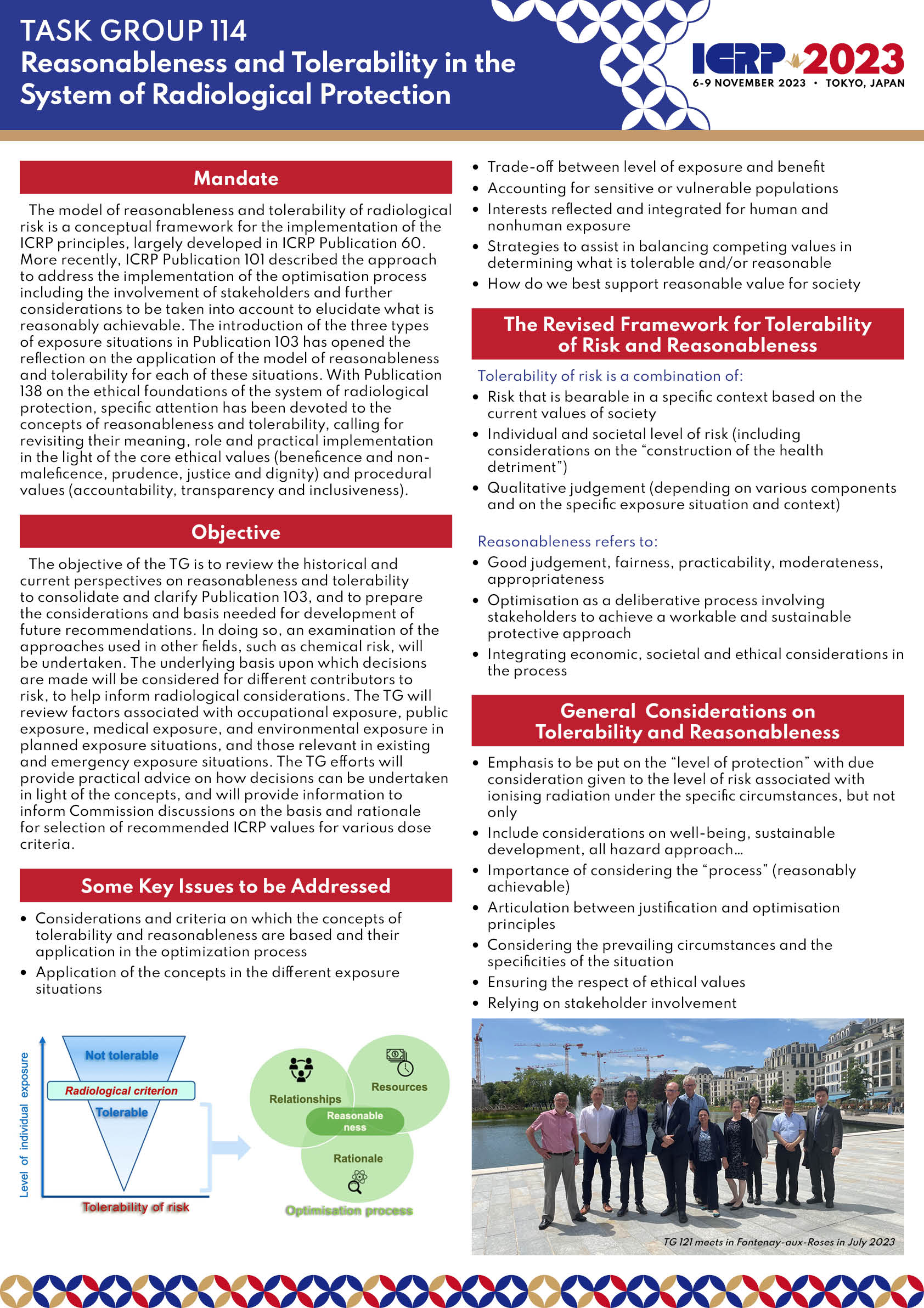Task Group 114
Reasonableness and Tolerability in the System of Radiological Protection
Under Committee 4
Discussions of reasonableness and tolerability have been part of ICRP publications for many years, including the introduction of a model of risk tolerability in Publication 60 (1990). Publication 101 (2004) developed the approach to address the implementation of the optimisation process and the way to elucidate what is reasonably achievable. Publication 124 introduced the approach for protection of the environment. Publication 138 (2018) examined the ethical foundations of the RP system, identifying four core values underpinning the system of RP. For this Publication, issues of tolerability and reasonableness in application of the system of protection were recognized, but not treated specifically.
The model of reasonableness and tolerability of radiological risk is a conceptual framework for the implementation of the ICRP principles of optimisation (guided by constraints and reference levels) and limitation, based mainly on the level of exposure, and closely related to the level of risk. Potential exposures require consideration of the likelihood of an exposure occurring, as well as the magnitude of exposure should an event occur. This model provides guidance for the implementation of the principles in planned, emergency and existing exposure situations. Reasonableness plays a key role in the decisions regarding appropriate levels of protection and is the core of the implementation of the optimisation principle taking into account societal and economic aspects, and also protection of the natural environment, as well as organisms that are part of, and adds value to, people’s environment and livelihood. Reasonableness applies to any exposure situation as far as an optimisation process is implemented, although what may be considered reasonable will depend on the specifics of the situation and involvement of stakeholders in an inclusive process.
Discussions and reflection will engage a wide number of questions, including, for example: What is the link between tolerable and reasonable? Reasonable for whom? What are the considerations and criteria on which the concepts of tolerability and reasonableness are based? What is the trade-off between level of exposure and benefit? How do we account for sensitive or vulnerable populations? How are interests reflected and integrated for human and nonhuman exposure? How do we best support reasonable value for society? What are some strategies to assist in balancing competing values in determining what is tolerable and/or reasonable? Are the same criteria applicable for tolerability in all exposure situations? How do different paradigms used for non-radiological risks inform and contribute to radiological protection?
The objective of the Task Group is to review the historical and current perspectives on reasonableness and tolerability to consolidate and clarify Publication 103, and to prepare the considerations and basis needed for development of future recommendations. In doing so, an examination of the approaches used in other fields, such as chemical risk, will be undertaken. The underlying basis upon which decisions are made will be considered for different contributors to risk, to help inform radiological considerations. The TG will review factors associated with occupational exposure, public exposure, medical exposure, and environmental exposure in planned exposure situations, and those relevant in existing and emergency exposure situations. The TG efforts will provide practical advice on how decisions can be undertaken in light of the concepts, and will provide information to inform Commission discussions on the basis and rationale for selection of recommended ICRP values for various dose criteria.
Reasonableness and tolerability are central to the practical implementation of the system of protection, and considerations cross-cut all Main Commission and Committee interests. As such, connections will be maintained with all Committees, and the Main Commission engaged in the ongoing development.
ICRP 2023 Poster
| Thierry Schneider (Chair), CEPN, France | ||
| Sebastien Baechler (Member), Federal Office of Public Health, Switzerland | ||
| Yann Billarand (Member), France | ||
| Ik Jae Chung (Member), Seoul National University of Science & Technology, Korea | ||
| Toshimitsu Homma (Member), Nuclear Regulation Authority, Japan | ||
| Carl-Magnus Larsson (Member), Norwegian Radiation and Nuclear Safety Authority, Norway | ||
| Jean-Francois Lecomte (Member), France | ||
| Bernard Le-Guen (Member), International Radiation Protection Association (IRPA), France | ||
| Reinhard Loose (Member), Hospital Nuremberg, Germany | ||
| M. Mahesh (Member), Johns Hopkins Medical Institution, USA | ||
| Nicole Martinez (Member), Clemson University, USA | ||
| Haruyuki Ogino (Member), Nuclear Regulation Authority, Japan | ||
| Werner Rühm (Member), Federal Office for Radiation Protection (BfS), Germany | ||
| Shoji Tsuchida (Member), Kansai University (Graduate School and Faculty of Societal Safety Sciences), Japan | ||
| Jessica Wieder (Member), U.S. Environmental Protection Agency, USA | ||
| Momo Takada (Member-Mentee), National Institute of Advanced Industrial Science and Technology (AIST), Japan | ||
| Camille Pacher (Technical Secretary), Canada | ||
| Anna Clark (Representative), International Atomic Energy Agency (IAEA), Austria |
